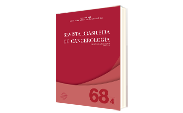Correlação entre os Parâmetros Clínicos, Patológicos e a Sobrevida Livre de Doença de Pacientes com Câncer Renal Tratados com Cirurgia em um Centro Oncológico do Sistema Público de Curitiba
DOI:
https://doi.org/10.32635/2176-9745.RBC.2022v68n4.2679Palavras-chave:
neoplasias renais, análise de sobrevida, nefrectomiaResumo
Introdução: O câncer renal corresponde a 13ª neoplasia mais incidente no mundo, sendo o terceiro tipo de câncer geniturinário mais comum. A maioria dos pacientes é assintomática, ocorrendo o diagnóstico de maneira incidental durante a realização de exames de imagem. O tratamento padrão-ouro é o cirúrgico. Objetivo: Correlacionar os parâmetros clínicos e patológicos com a sobrevida livre de doença em pacientes com câncer renal submetidos à nefrectomia. Método: Estudo retrospectivo com 99 pacientes submetidos a tratamento cirúrgico do câncer renal no período de 2010 a 2020. Foram comparados os parâmetros clínicos e patológicos com o desfecho clínico oncológico após nefrectomia. Resultados: Os 99 pacientes tiveram seguimento pós-operatório médio de 26,9 meses, sendo a sobrevida livre de doença (média) de 61,9%. A análise univariada demonstrou que as variáveis tamanho de tumor >7 cm e graus de Fuhrman III e IV estiveram relacionadas à progressão de doença após a nefrectomia (p=0,046 e IC=1,017-7,083; p=0,005 e IC=1,725-23,004, respectivamente). Na análise multivariada, o tamanho do tumor >7 cm (p=0,014 e IC=1,290-9,326) e os graus de Fuhrman III e IV (p=0,028 e IC=1,174-16,616) foram identificados como fatores preditores à progressão. Conclusão: O tamanho tumoral >7 cm e/ou os graus III ou IV de Fuhrman são fatores de risco para recorrência tumoral após o tratamento cirúrgico do câncer renal.
Downloads
Referências
Capitanio U, Bensalah K, Bex A, et al. Epidemiology of renal cell carcinoma. Eur Urol. 2019;75(1):74-84. doi: https://doi.org/10.1016/j.eururo.2018.08.036
Jemal A, Siegel R, Ward E, et al. Cancer statistics, 2009. CA Cancer J Clin. 2009;59(4):225-49. doi: https://doi.org/10.3322/caac.20006
Jemal A, Siegel R, Ward E, et al. Cancer statistics, 2006. CA Cancer J Clin. 2006;56(2):106-30. doi: https://doi.org/10.3322/canjclin.56.2.106
Atkins MB. Clinical manifestations, evaluation, and staging of renal cell carcinoma [Internet]. UpToDate. [date unknown] [updated 2022 Jan 21; cited 2022 Apr 19]. Available from: https://www.uptodate.com/contents/clinical-manifestations-evaluation-and-staging-of-renal-cell-carcinoma?sectionName
Brierley JD, Gospodarowicz MK, Wittekind C, editors. TNM classification of malignant tumors [Internet]. 8th ed. Genève (FR): Union for International Cancer Control; 2009.
Klatte T, Ficarra V, Gratzke C, et al. A literature review of renal surgical anatomy and surgical strategies for partial nephrectomy. Eur Urol. 2015;68(6):980-92. doi: https://doi.org/10.1016/j.eururo.2015.04.010
Zisman A, Pantuck AJ, Chao D, et al. Reevaluation of the 1997 TNM classification for renal cell carcinoma: T1 and T2 cutoff point at 4.5 rather than 7 cm. better correlates with clinical outcome. J Urol. 2001;166(1):54-8. doi: https://doi.org/10.1016/S0022-5347(05)66075-2
MacLennan S, Imamura M, Lapitan MC, et al. Systematic review of perioperative and quality-of-life outcomes following surgical management of localised renal cancer. Eur Urol, 2012;62(6):1097-117. doi: https://doi.org/10.1016/j.eururo.2012.07.028
Patard JJ, Pantuck AJ, Crepel M, et al. Morbidity and clinical outcome of nephron-sparing surgery in relation to tumour size and indication. Eur Urol. 2007;52(1):148-54. doi: https://doi.org/10.1016/j.eururo.2007.01.039
Atkins MB, Bakouny Z, Choueiri TK. Epidemiology, pathology, and pathogenesis of renal cell carcinoma [Internet]. UpToDate. [date unknown] [updated 2022 Sept 20; cited 2020 Apr 19]. Available from: https://www.uptodate.com/contents/epidemiology-pathology-and-pathogenesis-of-renal-cell-carcinoma
Dall’Oglio MF, Crippa A, Camara C, et al. The beginning of the 21st century: A paradigm shift in the surgical management of renal cell carcinoma in South America. Int Braz J Urol. 2010;36(6):670-7. doi: https://doi.org/10.1590/S1677-55382010000600004
Ferreira JC, Patino CM. What is survival analysis, and when should I use it? J Bras Pneumol. 2016;42(1):77-77. doi: https://doi.org/10.1590/S1806-37562016000000013
Kontak JA, Campbell SC. Prognostic factors in renal cell carcinoma. Urol Clin North Am. 2003;30(3):467-80. doi: https://doi.org/10.1016/S0094-0143(03)00020-X
Patard JJ, Dorey FJ, Cindolo L, et al. Symptoms as well as tumor size provide prognostic information on patients with localized renal tumors. J Urol. 2004;172(6 Pt 1):2167-71. doi: https://doi.org/10.1097/01.ju.0000141137.61330.4d
Dall’Oglio MF, Ribeiro-Filho LA, Antunes AA, et al. Microvascular Tumor Invasion, Tumor Size and Fuhrman Grade: A Pathological Triad for Prognostic Evaluation of Renal Cell Carcinoma. J Urol. 2007;178(2):425-8. doi: https://doi.org/10.1016/j.juro.2007.03.128
Downloads
Publicado
Como Citar
Edição
Seção
Licença
Os direitos morais e intelectuais dos artigos pertencem aos respectivos autores, que concedem à RBC o direito de publicação.

Este trabalho está licenciado sob uma licença Creative Commons Attribution 4.0 International License.









